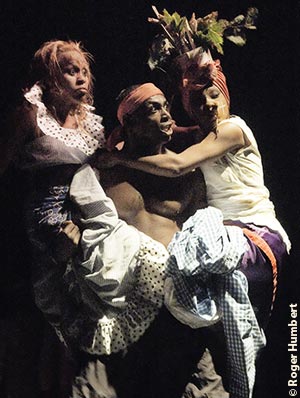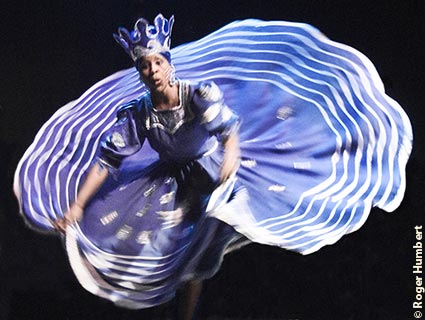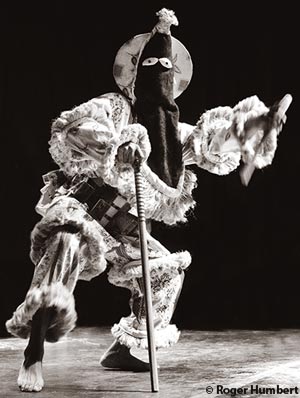 |
Yoruba Andabo
Presented by OKOKAN and Billy Bryans Productions |
|
| October 12, 2007 • The Phoenix Concert Theatre • Toronto |
|
|
|
|
|
|
Sacred and Profane, Ancient and Modern
by Joyce Corbett with photos by Roger Humbert |
| Yoruba Andabo is a renowned troupe of singers, dancers and percussionists born out of a weekly gathering of drummers and dancers on the docks of Havana. Not only are they keepers of African and Afro-Cuban traditions but they perform those traditions as fine art. In his introduction, Michael Marcuzzi, drummer and teacher at York University, tried to impress upon the audience the cultural significance and artistic mastery of Yoruba Andabo, all the while appearing to know that no brief description of their work could ever be adequate. When Cuban singer-rappera Telmary took over the microphone as M.C., the glow and pride with which she introduced these “defenders of tradition” raised our expectations even higher. Shortly into the show, it would become obvious why Yoruba Andabo has won so many awards (Latin Grammy 2000, Cubadisco 2005 among them) and gained such prestige. |
| The Yoruba were one of the largest ethnic groups among the slaves brought to Cuba. The name also designates their religion, their language and the territory in West Africa from whence they came. “Andabo” means follower, admirer or friend in the Caribali language of the Calabar region, another of the origins of African peoples exploited as slaves. Yoruba Andabo celebrates the varied African traditions of the Cuban people, both religious and popular, striving for authenticity while creating a powerful stage show. They also perform the popular music and dance which developed from the meeting of the African and European cultures.
The first piece of the show was titled “Congo” in the program. It opened with a woman carrying a clay pot containing greenery on her head, interacting with other, cigar-smoking, women, then launching a series of agile stick dances. An outburst of the fast and exciting Congolese makatu rhythm, ancestor of guaguancó and Columbia volleyed forth from the percussionists. Dancers danced erotic and portrayed a spirit possession.
|
|
 |
|
| “Yoruba”, arguably the most magnificent piece of the show followed. It was a vivid portrayal of the deities or orishas of Yoruban religion as they are known in Cuba. Each deity is associated with a traditional style of costume, representative colours and specific symbolic objects. Yoruba Andabo’s costumes and accessories were brilliant and sumptuous. |
| Particular types of movements are used for each deity. The Yemayá, or goddess of the sea, in this performance was expert at swirling the skirt of her dress, transforming its white horizontal stripes into waves moving through the blue sea of cloth. She would eventually leave the stage for the floor, still swirling in front of the beach of chairs and people. Of course this was after the playful trickster Elegguá, opener of the ways, had delighted us with his dance, strutted the stage and mirthfully sprayed beer from his mouth. |
|

Yemayá |
|
| The powerful god of iron and war, Oggún, was portrayed by a suitably large and powerful man resplendent in green, black and gold, clearing the road with his machete. As with all of the dancers we would see that night, not only were his movements flawlessly executed but the control over and use of facial expression was extraordinary. He would later strike his weapon against the axe of the virile Changó, god of thunder and lighting, but Obatálá, the essence of purity, justice, and clear thought, suitably clothed in cool white satin, would enter into no such strife. The orishas were convincing in their roles, illustrating their characters through movement, costume and expression, backed by the sounds of the ceremonial bátá drums and haunting ancient chants. |
| After intermission, we were immediately stirred by new sounds of equally ancient drums and chants, then startled by the appearance of the iremes, spirits of the dead from the secret societies of the Abakuá tradition. With their elaborately trimmed legs and long mask faces of black cloth tapering into a topknot, these were the most striking costumes of the evening. Very unique. After this surreal sensory experience came the secularly sexy rumba. For the guaguancó, Yoruba Andabo was joined by dancer Felix Pupy Insua, now based in New York City. Pupy and a perfectly sculpted female dancer displayed their sexiest moves in front of as well as on the stage; competitive, flirtatious and proud. Ending the show firmly in the present with a hip-swivelling connection to the ancient past, two young women in camouflage-patterned capris and two young men dressed in white, danced, rapped and sang to commanding rhythms. They flowed down onto the floor pulling people up to dance with them, then danced down the aisle with audience members following in a conga line. It was a light and fun ending to a wondrous evening, a rich experience of a complex culture, the sacred and the profane, the ancient and the modern. |
|

ireme |
|
|
| > more photos from performance < |
|
|
|
|
|




